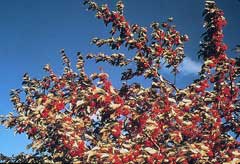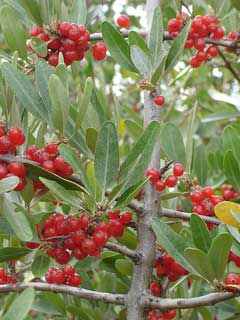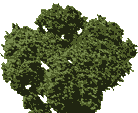 |
|
USDA photo |
 |
| http://commons.wikimedia.org/wiki/User:SriMesh |
Translate this page:
Summary
Shepherdia species
Shepherdia species are well-suited to poor soils and dry environments due to their drought tolerance and nitrogen-fixing abilities, which help improve soil fertility. Buffalo Berries are valuable as windbreaks, erosion control, and wildlife habitat. Silver Buffaloberry (S. argentea) produces edible red berries with a tart but pleasant flavour even before a frost. The berries are rich in vitamin C and can be eaten raw or used in jellies, sauces, and preserves. They can also be dried and used like currants.
Bloom Color: Yellow. Main Bloom Time: Late spring, Mid spring. Form: Rounded.
Physical Characteristics

 Shepherdia argentea is a deciduous Shrub growing to 4 m (13ft) by 4 m (13ft) at a medium rate.
Shepherdia argentea is a deciduous Shrub growing to 4 m (13ft) by 4 m (13ft) at a medium rate.
See above for USDA hardiness. It is hardy to UK zone 2 and is not frost tender. It is in flower in March, and the seeds ripen from July to December. The species is dioecious (individual flowers are either male or female, but only one sex is to be found on any one plant so both male and female plants must be grown if seed is required). . The plant is not self-fertile.
It can fix Nitrogen.
It is noted for attracting wildlife.
Suitable for: light (sandy), medium (loamy) and heavy (clay) soils, prefers well-drained soil and can grow in nutritionally poor soil. Suitable pH: mildly acid, neutral and basic (mildly alkaline) soils. It can grow in semi-shade (light woodland) or no shade. It prefers dry or moist soil and can tolerate drought. The plant can tolerate maritime exposure.
UK Hardiness Map
US Hardiness Map
Synonyms
Hippophae argentea. Elaeagnus utilis. Lepargyrea argentea
Plant Habitats
Woodland Garden Sunny Edge; Dappled Shade; Hedge;
Edible Uses
Edible Parts: Fruit
Edible Uses:
Fruit - raw or cooked[1, 2, 11, 61, 161, 257]. It can also be dried and used like currants[3, 46]. A tart but pleasant flavour even before a frost[85, 183], it becomes sweeter after frosts[3, 62, 95]. The fruit is also used for making preserves, pies etc[183]. The fruit should be used in moderation due to the saponin content[101]. The fruit is produced singly or in clusters, it is up to 9mm long and contains a single seed[229].
References More on Edible Uses
Medicinal Uses
Plants For A Future can not take any responsibility for any adverse effects from the use of plants. Always seek advice from a professional before using a plant medicinally.
Febrifuge Laxative Stomachic
The berries are febrifuge, laxative and stomachic[257]. They have been eaten in the treatment of stomach complaints, constipation and fevers[257].
References More on Medicinal Uses
The Bookshop: Edible Plant Books
Our Latest books on Perennial Plants For Food Forests and Permaculture Gardens in paperback or digital formats.

Edible Tropical Plants
Food Forest Plants for Hotter Conditions: 250+ Plants For Tropical Food Forests & Permaculture Gardens.
More

Edible Temperate Plants
Plants for Your Food Forest: 500 Plants for Temperate Food Forests & Permaculture Gardens.
More

More Books
PFAF have eight books available in paperback and digital formats. Browse the shop for more information.
Shop Now
Other Uses
Dye Hedge Hedge Soil stabilization
Agroforestry uses:
Buffaloberry is valuable in agroforestry for erosion control and soil stabilization. It can also serve as a windbreak and wildlife habitat. The berries are edible and can be harvested for culinary uses, providing a source of food for both humans and wildlife.
The plants can be grown as a hedge[160] and windbreak[229]. A red dye is obtained from the fruit[57, 106, 257]. Because it has a wide-ranging root system, forms thickets and is wind tolerant, it is sometimes planted for erosion control[229]. 1. Nectary - Flowers rich in nectar and pollen:
No – Buffaloberry flowers are typically small and wind-pollinated, providing little nectar or pollen for pollinators.
2. Wildlife - Food (Fruit, Seeds, Leaf litter, Shelter, Nesting, Roosting):
Yes – The berries are an important food source for birds and mammals. The dense, thorny shrubs also provide excellent shelter for wildlife, and the branches can be used for nesting by birds.
3. Invertebrate Shelter (Overwintering sites, Leaf litter, Groundcover):
Yes – The dense shrubs and rough bark offer overwintering sites for insects. Leaf litter can also provide cover for ground-dwelling invertebrates.
4. Pest Confuser (Smell):
No – Buffaloberry plants do not have a strong odor that would act as a pest deterrent.
Special Uses
Food Forest Hedge Hedge Nitrogen Fixer
References More on Other Uses
Cultivation details
Landscape Uses:Erosion control, Massing. Succeeds in an ordinary well-drained moisture retentive soil[1, 3, 11]. Tolerates poor dry soils[200] and maritime exposure[182]. Established plants are drought resistant[182]. A very cold-tolerant plant[229]. Plants rarely produce fruit in Britain[11]. Occasionally cultivated for its edible fruit, there are some named varieties[183]. 'Xanthocarpa' has yellow fruits[200]. The fruit is difficult to harvest because the shrub is very thorny[3]. Plants in this genus are notably resistant to honey fungus[200]. This species has a symbiotic relationship with certain soil bacteria, these bacteria form nodules on the roots and fix atmospheric nitrogen. Some of this nitrogen is utilized by the growing plant but some can also be used by other plants growing nearby[200]. Dioecious. Male and female plants must be grown if fruit and seed are required. Special Features:Attractive foliage, North American native, Inconspicuous flowers or blooms. The plant is heat tolerant in zones 6 through 1. (Plant Hardiness Zones show how well plants withstand cold winter temperatures.
Plant Heat Zones show when plants would start suffering from the heat.
The Plant Heat Zone map is based on the number of "heat days" experienced in a given area where the temperature climbs to over 86 degrees F (30°C).
At this temperature, many plants begin to suffer physiological damage. Heat Zones range from 1 (no heat days) to 12 (210 or more heat days).
For example Heat Zone. 11-1 indicates that the plant is heat tolerant in zones 11 through 1.). Buffaloberry plants are dioecious, which means that separate male and female plants are required for fruit production. The berries are typically harvested in late summer to early autumn, around August to September (Northern hemisphere), once they have ripened.
Buffalerry usually flowers in the spring, around April to May (Northern hemisphere), depending on the species and environmental conditions. Buffaloberry is a relatively slow-growing shrub, reaching maturity in about 3 to 5 years. It can grow to a height of about 1 to 3 meters (3 to 10 feet) and is well-suited to a variety of soil conditions, including dry and rocky soils.
References Carbon Farming Information and Carbon Sequestration Information
Temperature Converter
Type a value in the Celsius field to convert the value to Fahrenheit:
Fahrenheit:
The PFAF Bookshop
Plants For A Future have a number of books available in paperback and digital form. Book titles include Edible Plants, Edible Perennials, Edible Trees,Edible Shrubs, Woodland Gardening, and Temperate Food Forest Plants. Our new book is Food Forest Plants For Hotter Conditions (Tropical and Sub-Tropical).
Shop Now
Plant Propagation
Seed - it must not be allowed to dry out[113]. It is best harvested in the autumn and sown immediately in a cold frame. Stored seed requires 2 - 3 months cold stratification[113]. Prick out the seedlings into individual pots once they are large enough to handle. If sufficient growth is made it will be possible to plant them out in the summer, otherwise grow them on in a cold frame for their first winter and plant them out in the following spring or early summer. Cuttings of half-ripe wood, July/August in a frame sometimes work[113].
Other Names
If available other names are mentioned here
Rabbit berry, Thorny buffalo berry, Nebraska currant,
Native Range
NORTHERN AMERICA: Canada (Saskatchewan, Alberta (south), Manitoba (south)), United States (Iowa (northwest), Minnesota (west), Nebraska, North Dakota, South Dakota, Montana, Oregon (southeast), Wyoming, New Mexico (north), Arizona (north), California (east & south), Nevada, Utah)
Weed Potential
Right plant wrong place. We are currently updating this section.
Please note that a plant may be invasive in one area but may not in your area so it's worth checking.
Conservation Status
IUCN Red List of Threatened Plants Status :

Growth: S = slow M = medium F = fast. Soil: L = light (sandy) M = medium H = heavy (clay). pH: A = acid N = neutral B = basic (alkaline). Shade: F = full shade S = semi-shade N = no shade. Moisture: D = dry M = Moist We = wet Wa = water.
Now available:
Food Forest Plants for Mediterranean Conditions
350+ Perennial Plants For Mediterranean and Drier Food Forests and Permaculture Gardens.
[Paperback and eBook]
This is the third in Plants For A Future's series of plant guides for food forests tailored to
specific climate zones. Following volumes on temperate and tropical ecosystems, this book focuses
on species suited to Mediterranean conditions—regions with hot, dry summers and cool, wet winters,
often facing the added challenge of climate change.
Read More
Expert comment
Author
(Pursh.)Nutt.
Botanical References
1143200
Links / References
For a list of references used on this page please go here
Readers comment